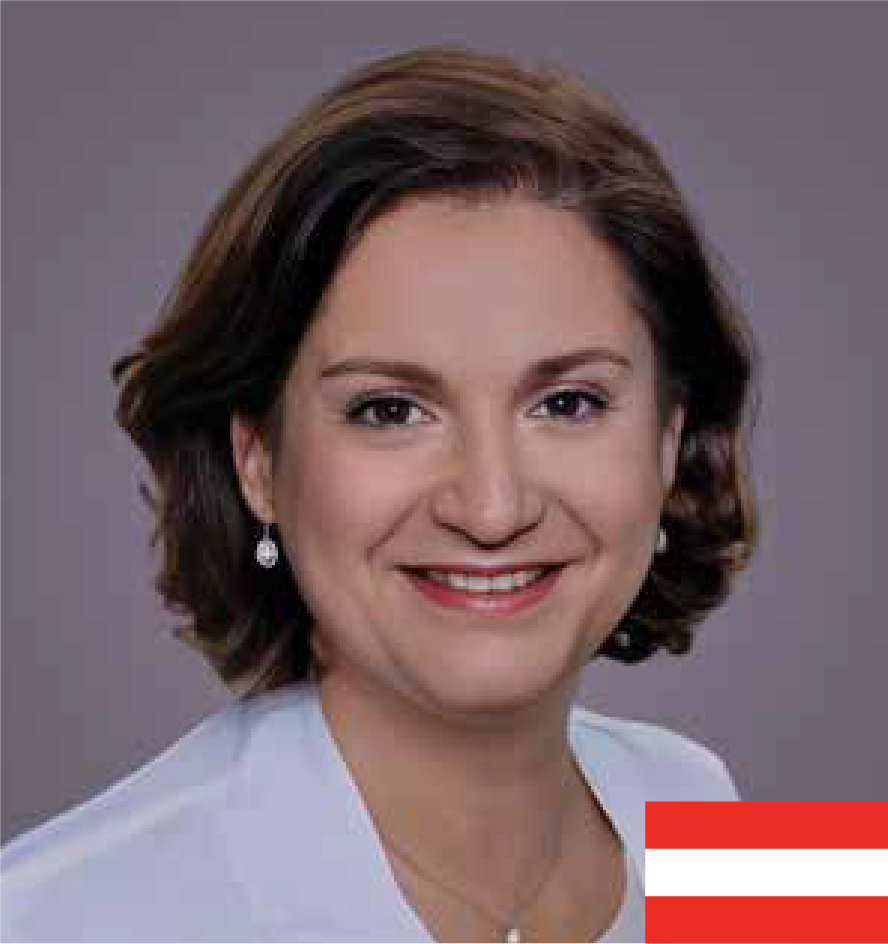
Join a panel of internationally renowned surgeons as they present the world’s first clinical data on the next-generation RayOne Galaxy spiral IOL platform from Rayner.
RayOne Galaxy’s unique optical spiral was created using a proprietary AI engine trained on patient outcomes, resulting in optimised visual acuity, a continuous full range of vision, and reduced dysphotopsia.
Hear how the spiral lens works, surgical experiences from the world’s first implanters, as well as case reports and patient feedback.
Sunday 08 September 2024, 13:00-14:00
Room 8.1 O

Moderator – Advanced technology IOLs and current challenges

Introducing the new Galaxy spiral IOL

Pre-clinical and global evaluations

First surgeries and personal experiences

Case reports and patient feedback
For programme updates, please visit the official ESCRS programme website at https://congress.escrs.org/programme
Sulcus add-on IOL
Sulcus add-on IOL - Surgical Pearls on Supplementary IOLs
Optical Performance And Visual Outcome Of IOL With Controlled Positive Spherical Aberration
Matching IOL style with spherical aberration profile
Introduction. What is and what is not an EDOF intraocular lens?. Understanding and classifying EDOF lenses.
Refining Micro-Monovision Through Monofocal Plus Intraocular Lenses
Exploring The Effect Of Corneal Spherical Aberration And Chord µ On Depth Of Focus With A Non-Diffractive Enhanced Monofocal Intraocular Lens (A Pilot Study)
Visual Outcomes And Patient Satisfaction After Implantation Of An Enhanced Monofocal Intraocular Lens For Mini-Monovision
Comparison Of Contrast Sensitivity And Visual Acuity In Patients Bilaterally Implanted With An Enhanced Monofocal IOL: Binocular Emmetropic Target Versus Modest Monovision
Visual Outcomes Of Cataract Surgery In Patients After Presbyond Laser Blended Vision
Refractive Outcomes, Visual Acuity, Rotational Stability, Decentration, And Tilt Of A New Toric Enhanced Monofocal Hydrophilic Acrylic Intraocular Lens: A Retrospective Analysis
Matching Patient Needs with Evolving Presbyopia-Correcting Lens Technologies
The Galaxy Spiral IOL: World’s First Clinical Data
Blended Vision With A Monofocal IOL Inducing Positive Spherical Abberations In A High Myopic Patient
Exploring The Effect On Stereoscopic Vision After Mini-Monovision Approach In Cataract Patients With Non-Diffractive Enhanced Monofocal Intraocular Lens (IOL)
How To Obtain Funcional Near Vision By Implanting A New Toric Mono Focal Plus Lens In Cataract Surgery
Comparative Evaluation Of Visual Outcomes After Bilateral Implantation Of Two Advanced Monofocal Lenses: Rayone Emv Versus Envista Aspire
Presbyopia correcting phakic IOL (PIOL) vs presbyopia correcting posterior chamber IOLs in 45 -50 year olds?: Pro: Supplementary presbyopia-correcting IOL in the sulcus
Astigmatism correction and visual outcomes with a new increased range of vision enhanced monofocal toric IOL: A real-world multicenter evaluation
Comparing The Visual Performance And Patient Satisfaction In Cataract Patients With Two Toric Non-Diffractive Increased Range Of Focus Intraocular Lenses (IOLs) Using Mini-Monovision
Enhanced monofocal IOLs – What is available, what we can expect clinically
The Optics Behind Non-Diffractive Enhanced Monofocals and EDoF Technology and its Role in Mitigating Dysphotopsia
Patients Reported Outcomes (PROM) after use of RayOne EMV
Comparative analysis of the RayOne EMV IOL with a wavefront shaping IOL
Clinical Outcome After DUET Procedure
Visual Outcomes And Patient Satisfaction After Bilateral Refractive Lens Exchange With A Trifocal Toric And Non-Toric Intraocular Lens In Presbyopic Patients
Decision-Making in different situations
Evaluation Of Visual Quality And Independence Of Optical Correction, With Advanced Monofocal Intraocular Lenses With Positive And Negative Spherical Aberration Under Photopic And Scotopic Conditions
Real-world assessment of contrast sensitivity, spectacle independence and subjective feedback in patients implanted with an enhanced monofocal to increase the range of focus in Spain
Visual Outcomes And Defocus Profile With An Enhanced Monofocal Intraocular Lens Utilizing Controlled Positive Spherical Aberration
Comparing Performance At Different Distances With Mini-Monovision (Offset -0.75) And Subjective Refraction Of 4 Increased Range Of Focus Non-Diffractive Iols Using Positive Or Negative Spherical Aberration Optics
Clinical outcomes after bilateral implantation of an enhanced monofocal intraocular lens in myopic patients with myopic targets in both eyes
Intraindividual Comparison Of Visual Performance And Satisfaction With Sulcoflex Trifocal Supplementary Intraocular Lens In Conjunction With Enhanced Monofocal (RayOne EMV) Versus Standard Monofocal (RayOne Aspheric) Intraocular Lens
Evaluating The Visual Performance Of Increased And Full Range Of Focus IOLs Using Patient Collected Outcomes Post Operatively From Cataract Surgery Using The RayPRO Digital Platform
Sustainable Innovation In Cataract Surgery: A Groundbreaking Initiative By Royal Free London NHS Trust To Reduce Carbon Footprint And Promote Environmental Stewardship
Multicentre Correlation Analysis Of Parameters Influencing Patient Satisfaction: Insights From The RayPRO Database
A Prospective Randomized Control Trial To Measure Posterior Capsular Opacification Rates Following Insertion Of Two Monofocal, Aspheric, Acrylic Intraocular Lenses: The Hydrophobic RayOne 800C And The Hydrophilic RayOne 600C: Twelve-Month Results
Effect Of Pupil Size And Corneal Spherical Aberrations On Premium Lenses' Optical Performance
Evaluation of cylinder reduction with a new enhanced monofocal toric IOL at six month after bilateral implantation – a case report with a female patient
The impact of modest monovision upon clinical outcomes after bilateral cataract surgery with an enhanced monofocal IOL optimized for 1D of monovision offset
Analysis of results after combined cataract surgery and transscleral micropulse laser therapy (MP-TLT) with an enhanced monofocal lens implantation
Monofocal Plus IOL - Rayner EMV – Our Own 1-Year Experience With Micro- And Minimonovision
First Clinical Outcomes With New Full Range Of Vision Iol: The Next Generation Optic Design
Clinical Outcomes Of The Rayner RayOne Trifocal
Managing A New Patient Presenting With A Refractive Surprise Post Cataract Surgery In One Eye And A Cataract In The Other
Quality Of Life And Spectacle Independence With Different Monofocal+ And Edof Iols Based On Over 5000 Raypro System Records
Rotational Stability Of A Toric Enhanced Range Of Focus Iol
Clinical Results After Monocular Or Binocular Implantation Of Toric And Non-Toric Enhanced Monofocal Intraocular Lenses In A Real-World Setting In India
Micro Monovision with a new Enhanced Monofocal IOL: Results after Bilateral Implantation in 50 Patients
Modification Of Surgical Procedure To Achieve Independence From Glasses In A Patient With An Incorrectly Implanted Add-On Lens
Exploring Early Clinical Outcomes of the Next Generation Full Range of Vision IOL
Rotational Stability Of The Rayner RayOne EMV Toric IOL
Evaluation of cataract treatment results using phacoemulsification surgery method with a standard monofocal lens implant in one eye and an enhanced monofocal IOL in the other eye
First Visual Results With A New Non-Diffractive “Enhanced” Monofocal Iol In A Blended Vision Strategy And Evaluation Of Photopic Phenomena
Clinical Outcomes Of An Enhanced Monofocal Intraocular Lens After Cataract Surgery In Eyes With Age-Related Macular Degeneration
Refractive and Binocular Visual Outcomes with an enhanced monofocal IOL in cataract patients: A Real-World Clinical Audit in Western Australia
Defocus Curve Analysis With New Enhanced Monofocal Intraocular Lenses Rayone EMV And RayOne EMV Toric
Refractive Surgery In A Pseudophakic Patient With An Epiretinal Membrane Using A Secondary Sulcoflex® Trifocal Rayner Lens Implant
Enhanced Monofocal Intraocular Lenses Targeted For Binocular Emmetropia Or Moderate Myopia In The Nondominant Eye: Comparison Of Visual Outcomes And Patient Satisfaction
Clinical Results After Combining Mini-Monovision With Binocular Implantation Of A Nondiffractive Monofocal Intraocular Lens With Extended Depth Of Focus
Short-term impact of hypertonic solution on early corneal oedema recovery after cataract surgery
Comparison Of Outcomes of Two Extended Depth Of Field Intraocular Lenses
Visual Outcomes Of Cataract Patients After Implantation With Toric And Non-Toric Enhanced Monofocal Intraocular Lenses In A Real-World Setting In The UK
Implantation of a enhanced monofocal EDOF IOL in the second eye - Improve the satisfaction of first eye with implantation of diffractive trifocal IOL
Comparison Of Visual Outcomes Of Two Advance Monofocal Iols Based On Different Optical Principles
Safety And Effectiveness Of Ophthalmic Visco-Surgical Device Containing Free Radical Scavenging Sorbitol In Cataract Patients With Corneal Endothelial Disease
Not all Rayner products are approved for sale in every country.